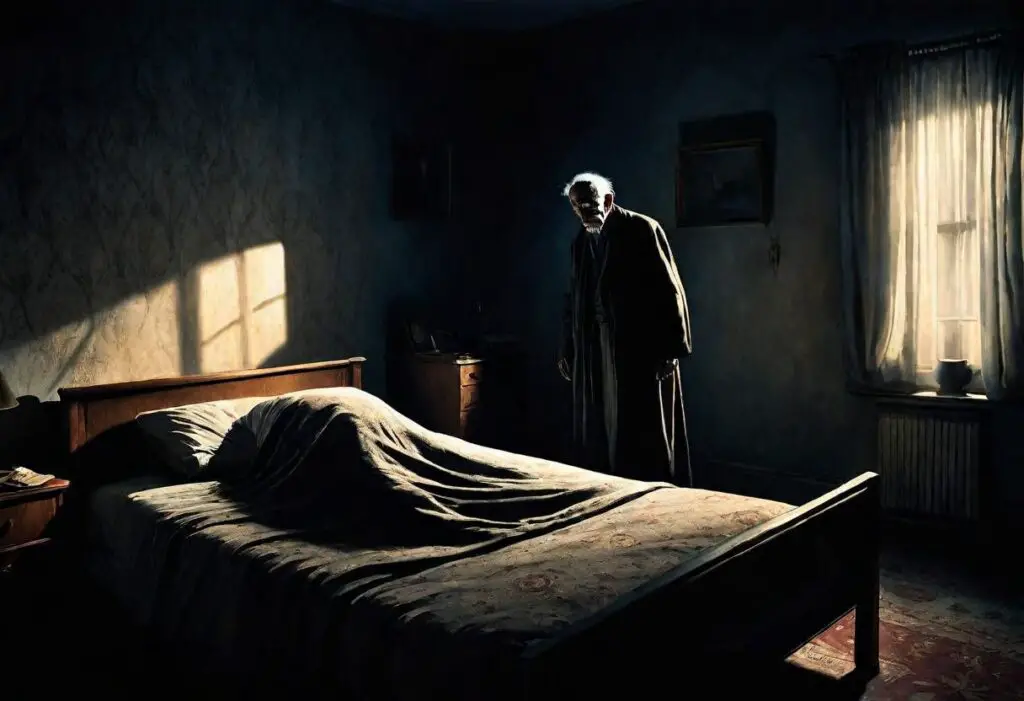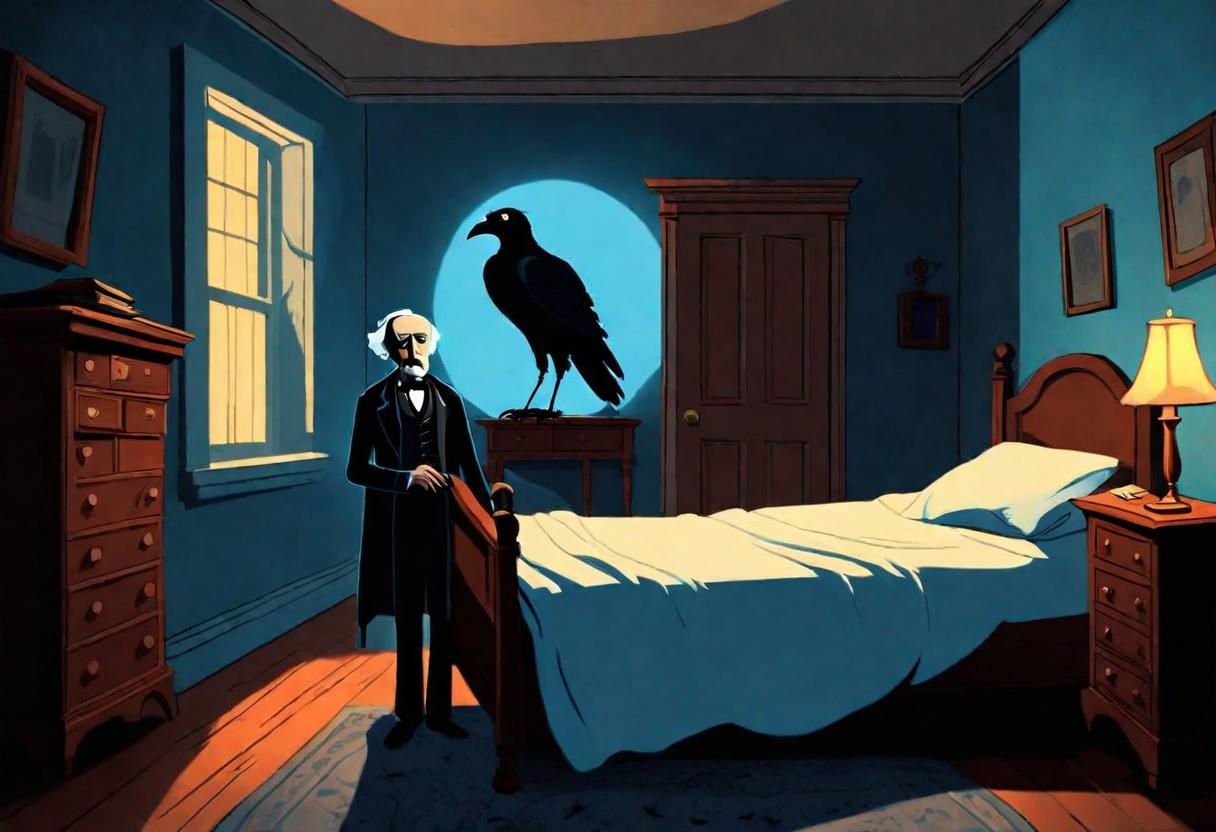The house lay dark and silent, with the old man’s pale blue eye ominously glowing in the shadows. As each night passed, the sound of a heartbeat intensified, thickening the air with fear. Tonight, an impending sense of dread signaled that something terrible was about to unfold. The Tell-Tale Heart By Edgar Allan Poe
Introduction to Tell-Tale Heart:
“The Tell-Tale Heart” is a short story written by Edgar Allan Poe. It is one of his most famous works, as we known for its gothic and suspenseful atmosphere. This story is often studied in schools due to its straightforward plot and intriguing themes. In this article, we will explore the story in simple and basic English, making it easy for everyone to understand.
Characters in Tell-Tale Heart:
The Narrator:
The protagonist of the story, whose name and gender remain undisclosed, narrates the chilling tale. They claim to be sane but exhibit clear signs of madness however their obsession with the old man’s eye leads to murder.
The Old Man:
The victim of the narrator’s obsession. He possesses a pale blue eye reminiscent of a vulture’s, unaware of the narrator’s intentions, and additionally meets his demise in his sleep.
The Police Officers:
They arrive at the house after a neighbor reports a scream. They are courteous and unsuspecting but ultimately witness the narrator’s breakdown and confession.
Summary of The Tell-Tale Heart:
In “The Tell-Tale Heart,” an unnamed narrator recounts a murder they committed while vehemently asserting their sanity. The narrator lives with an old man who has a vulture-like pale blue eye that deeply disturbs the narrator. However he believes that the eye is evil, the narrator decides to kill the old man to rid themselves of the eye forever.
For seven nights, the narrator covertly enters the old man’s room to observe him sleeping, but finds the eye always closed, thwarting their plans. On the eighth night, the old man awakens and opens his eye, giving the narrator the opportunity to act. The narrator kills the old man by suffocating him with the bed and then dismembers the body, hiding the pieces under the floorboards.

Shortly thereafter, the police arrived, responding to a neighbor who heard a scream. The narrator confidently entertains the officers, claiming that the old man is away. However, as they converse, the narrator begins to hear a thumping sound, which grows louder and more unbearable. Convinced that it is the heartbeat of the old man coming from beneath the floorboards, the narrator’s guilt and finally paranoia lead to a confession of the murder.
Detailed Summary of Each Part:
Beginning
The story begins with the storyteller insisting they are not mad. They explain that they decided to kill the old man because of his eye. They describe how the eye made them feel very uncomfortable. The storyteller is very careful and plans the murder over several days.
Middle
For seven nights, the storyteller stealthily enters the old man’s room to watch him sleep. Each night, they proceed with utmost quietness and caution. But the old man’s eye is always closed, so they cannot kill him. On the eighth night, the old man wakes up. The storyteller shines a light on the eye, which is open. This gives them the chance to act. The storyteller kills the old man by pressing the bed down on him until he dies.
After the Murder
After killing the old man, the storyteller cuts up the body and hides the pieces under the floor. They clean up everything so there is no trace of the crime. The storyteller is very proud of how well they have covered up the murder.
The Police Arrive
Soon, the police come to the house. Upon hearing a scream, a neighbor quickly alerted them. The storyteller remains composed and invites the police in, guiding them straight to the concealed room. Throughout their interaction, the storyteller maintains a relaxed demeanor, exchanging light-hearted banter with the police and exuding unwavering confidence.
The Confession
While talking to the police, the storyteller begins to hear a thumping sound. As the sound intensifies, growing louder and louder, the storyteller believes it to be the old man’s heartbeat emanating from beneath the floor. The unbearable noise pushes the storyteller to their breaking point, ultimately prompting a confession of the murder and imploring the police to excavate the floor to uncover the body.
Themes in The Tell-Tale Heart:
Guilt and Paranoia:
Moreover, the story delves into the psychological effects of guilt. The narrator is driven to madness by their own conscience, symbolized by the incessant beating of the heart they hear.
Sanity and Insanity:
Additionally, while the narrator insists on their sanity, their actions and thoughts reveal a descent into madness. This stark contrast highlights the thin line between sanity and insanity.
The Nature of Evil:
Furthermore, the narrator’s obsession with the old man’s eye suggests a belief in supernatural evil. The eye is portrayed as a malevolent force that must be destroyed.
The Unreliable Narrator:
Lastly, told from the narrator’s perspective, whose reliability is questionable, the story creates a sense of uncertainty and suspense, leaving readers to interpret the truth for themselves.
Symbols in Tell-Tale Heart:
The Eye:
As for the old man’s eye, it serves as a symbol of evil to the narrator, resembling a vulture’s eye commonly associated with death. This causes the narrator immense distress, compelling them to commit murder.
As for the heartbeat, it represents the narrator’s overwhelming guilt. Following the murder, the heart beats louder and louder, symbolizing their increasing fear and troubled conscience.
Structure and Style in The Tell-Tale Heart:
Plot:
The story follows a straightforward plot with a clear beginning, middle, and end. The simple structure makes it easy to follow the events as they unfold, but the psychological depth adds complexity.
Language:
Poe uses precise and vivid language to create a dark and eerie atmosphere. The repetitive and detailed descriptions emphasize the narrator’s obsessive nature and growing madness.
Imagery:
The story is rich with imagery that evokes horror. Descriptions of the old man’s eye and the dismemberment of his body are particularly graphic and contribute to the story’s intense and unsettling mood.
Narrative Style:
Told from a first-person perspective, the story allows readers to directly experience the narrator’s thoughts and feelings. Consequently, this approach cultivates an intimate and intense connection with the narrator’s psychological state.
Unreliable Narrator: The narrator insists they are sane, but their actions and thoughts suggest otherwise. This unreliability creates a sense of uncertainty and tension, making readers question what is real and what is imagined.
Suspense and Tension: Poe masterfully builds suspense through the narrator’s meticulous planning and the gradual reveal of their madness. The tension peaks when the police arrive, and the narrator hears the imagined heartbeat, leading to a dramatic confession.
Key Moments in the Story:
The Decision to Kill: The storyteller decides to kill the old man because of his eye. This is the start of the whole story.
On the eighth night, the old man awakens and opens his eye, prompting the storyteller to finally act.
The Murder: The storyteller kills the old man by suffocating him with the bed. This is the climax of the story.
The Police Visit: When the police arrive at the house to check on things, the storyteller engages them in conversation and tries to act normal.
The Confession: The storyteller hears the beating heart and confesses to the murder. This is the resolution of the story.
Conclusion:
“The Tell-Tale Heart” by Edgar Allan Poe is a story that keeps readers on the edge of their seats. It is simple to follow but full of psychological depth. The themes of guilt, madness, and evil make us think deeply. By understanding the characters, themes, and story structure, we can see why this story is so famous.
This article used very simple and basic English to explain “The Tell-Tale Heart.” Whether you are reading it for school or just for fun, we hope this guide helped you understand the story better.
